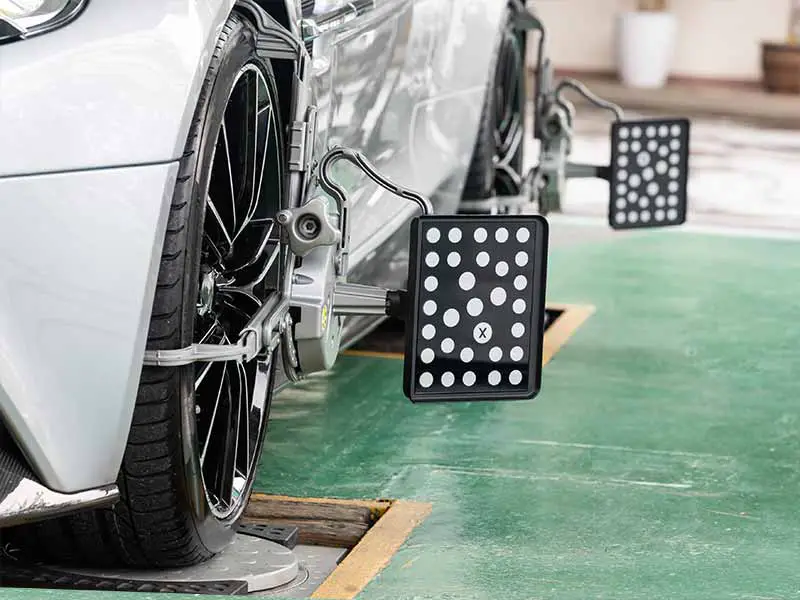Many people have strong opinions about the importance of the condition of tires when having a vehicle alignment performed. Some believe worn tires, especially those with uneven tread wear, will negatively affect the alignment process.
Can I Get An Alignment With Bad Tires?
Yes, you can get an alignment with bad tires. The condition of your tires will have no effect on how well the technician and the alignment machine will be able to perform an alignment service accurately.
There are a few more questions about purchasing tires and alignments that are related to this seemingly simple question.
Let’s take a closer look.

Do You Need New Tires For An Alignment?
No, you do not need new tires to get your alignment checked and adjusted. In fact, some alignment machines work without tires mounted on your car or truck.
Some people believe that uneven tire wear patterns can affect the alignment process. However, this isn’t true. When thinking about it, it makes sense that this could be a problem. But in reality, tire wear doesn’t affect how your vehicle’s alignment is adjusted.
If you have unevenly worn tires, this is a very strong indicator that you need to have an alignment service performed. One of the most common signs of an improper wheel alignment is uneven tire wear.
Can You Get New Tires After An Alignment?
Yes, you can get new tires after having an alignment service performed. It’s best to have your car or truck realigned before or when purchasing new tires.
The reason is that an alignment will ensure that your suspension components are correctly aligned to get the most even wear and longest life out of your new tires.
If you purchase a new set of tires because the old tires didn’t last as long as they should have, there’s a good chance the alignment was the largest part of the problem.
Proper alignment specs affect tire wear. If your vehicle’s suspension isn’t adjusted to within the vehicle manufacturer’s recommended settings, you’ll experience excessive tire wear. When these settings are incorrect, your tires drag slightly as you drive down the road. Out-of-alignment tires may ride more on the outer or inner parts of the tread. Or they may be turned slightly away from the direction of travel.

Should I Get New Tires Or An Alignment First?
It would be best if you got an alignment first and then new tires. Alternatively, you can have your vehicle’s alignment adjusted at the same time as you purchase your new tires.
If you need to purchase a new set of tires but wait to have a wheel alignment done, it’s not the end of the world. If your worn tires were evenly worn and you didn’t have issues such as an off-center steering wheel, pulling to one side or the other, or excessive tire noise, you may not have any serious alignment issues.
However, if you haven’t had a tire alignment performed within the last 10,000 miles, we recommend that you do so as soon as you can manage to have one done to help ensure you get the best tire life, fuel economy, and handling performance from your investment in your new tires.
Do You Always Need An Alignment With New Tires?
You don’t always need an alignment when purchasing a new set of tires, but it is usually an excellent idea. An exception to this would be having a wheel alignment performed recently and not having uneven wear on your old tires.
All modern vehicles will have their wheel alignment drift out of spec over time. Even with the best road conditions and driving habits, potholes, curbs, and normal wear and tear take a toll on your vehicle’s suspension parts over time.
Hard hits can bend control arms or tie rods. They can also damage bushings in many different suspension parts. All of this damage ends up causing alignment issues over time. Small amounts of damage can be corrected with regular vehicle alignment. More significant issues may require the replacement of bent suspension system components or worn steering linkages before your car or truck can be adjusted back into proper alignment.

Do You Need An Alignment After Replacing One Tire?
You may need an alignment after replacing one tire. Often, when one tire is replaced, it is due to an unrepairable flat or other non-repairable tire problem, like a sidewall bulge.
Sometimes flat tires or tire damage occurs during an accident or a hard impact with a pothole or curb. Flat tires can occur from sharp road debris that may not be large enough to affect tire alignment. Damage to a tire from a hard impact severe enough to require replacement should at least have an alignment check.
When Should Alignment Be Done?
A vehicle’s alignment should be checked every 10,000 miles or when any of the following situations occur:
- Your vehicle pulling toward the side of the road
- Your steering wheel is off-center when driving straight
- You have unevenly worn tires
- You have suspension parts replaced (such as shock absorbers)
- Your vehicle’s ride height has been raised or lowered
- After an accident or hitting a large pothole or curb at high speeds
Resources
Below are some links you may find helpful when learning about tires
- Is it time for a wheel alignment? – Firestone
- Do I really need an alignment for my vehicle? – Les Schwab
Final Thoughts
Generally speaking, it doesn’t matter what condition your tires are in when you get a wheel alignment. You don’t need new tires just for an alignment.
If you need to purchase a new set of tires, it’s recommended to have your car or truck realigned either before or at the time of purchasing new tires to ensure your suspension system is aligned so your tires will last as long as possible and wear evenly.
Good luck and happy motoring.





